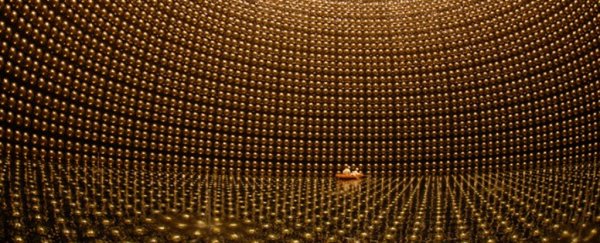We're all here only because reality is an imperfect reflection of itself. Thanks to a flaw in the symmetry of nature, plenty of material was available to clump into the billions of galaxies we now see in the Universe.
Nearly a decade's worth of data produced by the Tokai to Kamioka (T2K) particle physics experiment in Japan has provided the strongest evidence yet of an imbalance that could help explain why matter didn't vanish moments after it was first created.
The study looked for significant differences in how near-massless particles called neutrinos change form, compared with their 'mirror' particle, the antineutrino.
Ironically, neutrinos are so tiny, they barely even exist, slipping past most other particles without a pause. But what they lack in punch they make up for in sheer numbers, being a billion times more common than the particles that settle together to make up atoms.
In fact it's the abundance of neutrinos, mixed with their odd behaviour of switching properties – described as changing flavours – that attracts physicists seeking explanations for everything from dark matter to an apparent imbalance in the types of particles we see around us.
Back when the Universe was still a hot mess packed into a tiny (but expanding) space, the condensation of energy into particles should have resulted in a Noah's ark of particle pairs with opposing properties.
That means negatively charged electrons emerged alongside positively charged antimatter twins called positrons. Since matter combined with antimatter cancels out in a puff of radiation, space should be full of nothing more substantial than waves of light.
Obviously, this is not the case. At least, not entirely. Enough particles of matter stuck around to eventually create things like stars, comets, wombats and paper clips.
"Equal amounts of matter and antimatter were created in the early Universe, so an important question in cosmology is how we arrived at the Universe that we see today, which is dominated by matter," experimental particle physicist Lindsey Bignell from ANU in Australia told ScienceAlert.
Bignell wasn't part of the study, but knows a thing or two about the neutrinos' role in potentially explaining this strange imbalance.
"We don't have the full picture of how that happened yet, but we do know that CP violation is a necessary ingredient," says Bignell.
CP stands for charge swap and parity, referring to changes to particles that occur in opposition. For example, positive charges flip to negative ones when particles become antiparticles. As for parity, it's a shift in coordinates, not unlike your left hand is a mirror match for your right.
Flipping charges and parities in a system shouldn't change how physics works, so we'd say it obeys CP symmetry. If we did find a difference, we'd say that CP symmetry was violated.
If this break in symmetry was big enough for the right particles early in the Universe, it just might have a knock-on effect that could leave us with particles. It needn't be much either – just a few particles need to remain for every 10 billion photons produced.
One such violation had already been found earlier in 1964, when two American physicists indirectly spotted it among the statistics of a rare type of decay in bundles of quarks called kaons.
While it was a landmark discovery, the scale of this particular form of violation turned out to be nowhere near large enough to explain the imbalance in matter we see today.
Ever since, a number of physicists have pinned their hopes for a significant CP symmetry violation on other particle classes - such as the one containing electrons and neutrinos.
"One way we can infer the existence of CP violations in this system is to measure the oscillation patterns for neutrinos and antineutrinos," says Bignell.
"If CP is violated, they will differ. This is what the T2K collaboration has done."
Researchers at the Super Kamiokande detector kept measure of these oscillations in neutrinos after the particles had travelled from the Japanese Proton Accelerator Research Complex nearly 300 kilometres (about 180 miles) away.
Nine years' worth of results were then compared with models describing how the particles should change over that distance.
The mass of data in this study means we can be more certain than ever that a break in that all-important symmetry is what's behind the observed pattern in oscillating neutrino flavours.
"This paper from the T2K collaboration represents an extraordinary technical achievement and makes an important contribution to this question," says Bignell.
We're still far from a final answer on the question of why matter exists as it does, and will need to wait for future experiments to determine whether this particular violation will help to explain it. If not, we might need to wait for completely new physics.
This research was published in Nature.
